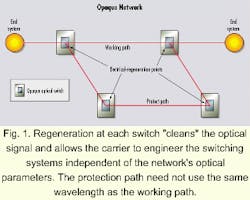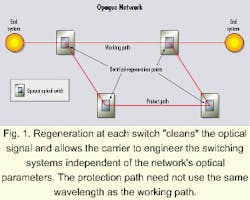Optical switches: Is one technology better than the other for carriers today?
As proponents debate the merits of opaque versus transparent switching systems, future networks may benefit from both approaches.
Unbridled demand for data-centric services and the continuing growth of voice are causing carriers to rapidly expand their networks to better serve customers. RHK, a South San Francisco, CA-based telecommunications analysis firm released its SONET and DCS forecast that reports data growth rates are exceeding 60% per year in some cases. Several carriers are describing their growth as violent. Even voice services continue to grow rapidly, with one carrier showing 53% growth per annum on voice services alone.
In this rapid growth environment, carriers quickly discover that traditional circuit switching and multiplexing systems can hamper profitability. The Synchronous Optical Network/Synchronous Digital Hierarchy (SONET/SDH) model does not scale well; legacy systems are either too costly, too operationally complex, and most often, both. To reduce network cost and complexity, carriers must adopt high-bandwidth optical-switching systems, which offer a scalable solution to control optical bandwidth in the Internet era.
Optical-switching systems intended to meet these requirements can be broadly categorized into two classes: opaque and transparent. Not surprisingly, there is lively debate about the merits and deficits of the basic technology behind these switching systems, as advances make both approaches viable.
While specific requirements for optical-switching systems may differ from carrier to carrier, the following characteristics are near the top of the list for all:
- Scalability to accommodate high capacity and rapid growth
- Bandwidth granularity to support a range of transport services
- Rapid protection to quickly recover from network or equipment faults and meet customers' required service levels
- Performance verification to monitor bit-error rates (BERs) for service-level verification
- Bottomline economics, including initial capital costs and the ongoing cost of ownership.
Unlike traditional SONET/SDH circuit switching and multiplexing systems, optical switches--opaque or transparent--can help carriers fulfill these requirements.
An opaque system requires one or more optical-to-electrical conversions, whereby an optical carrier is terminated in a photodiode and converted to an electrical signal. Within the electrical domain, the digital information carried by the signal can be monitored, managed, and eventually switched, using traditional, very-large-scale-integration technology.
A "truly" transparent system switches traffic without any conversions to electronics. Optical-component switches are commonly considered transparent because switching occurs only in the optical domain without any electrical conversion between the primary-end transmission points.
Advocates of opaque switching point out that the optical termination and electrical conversion required in these systems reduce the technology risks relative to emerging optical-switching elements. Moreover, as the cost of integrated circuits continues to decline while performance improves, opaque switching systems offer the scalability required for switching--and configuring--hundreds of high-speed channels. Opaque networks also allow a clean, standard interface between the optical-transport elements and the optical-switching elements; thus, the engineering of each is independent and simple. Isolating problems is easier due to well-defined monitoring points throughout the transmission and switching path.
Advocates of transparent switching hold a different view. This camp believes that transparent switching offers capital cost savings because it eliminates the optical-electrical-optical (O-E-O) conversion. Similarly, proponents point out there is an operational savings because transparent switching promises simple upgrades to faster data rates and new services. The reasoning behind this belief is that the optical-switching element, whether a micro-electromechanical switch, conventional lithium-niobate crystal, or any of a variety of technologies, switches light without regard to its bit rate or framing format.
Despite these arguments and the differences in the underlying technology, opaque and transparent switching systems will both meet carriers' needs-in different ways and to varying degrees.
Given the current growth rate of traffic on carriers' networks, scalability is generally near the top of any requirement list for optical-networking systems. Today, vendors tout upcoming systems capable of switching hundreds of 2.5-Gbit/sec streams. Almost all of the systems slated for availability this year take advantage of opaque switching technologies, implemented by high-density application-specific integrated circuits (ASICs) and standard O-E-O converters. The base technology, high-speed IC technology, is well known and used by the developers of Internet-protocol routers, Asynchronous Transfer Mode switches, Gigabit Ethernet switches, and other networking products. Optical-networking vendors can build ASIC-based switching elements with hundreds of input and output ports, without requiring new manufacturing or process technology.
Today's transparent components cannot support the same number of input and output ports as those based on electronics. Thus, in the near term, the scale of transparent systems is limited. Network operators can "cascade" multiple switching elements to create larger fabrics, until this approach is limited by either physical size or insertion loss. With certain technologies, integrating multiple optical switches on a chip can also overcome this limitation.
Carriers deploy optical-transport systems at 10 Gbits/sec or 2.5 Gbits/sec, yet still must sell services such as private line at lower speeds. Therefore, carriers also need to deploy switching systems for multiplexing these services. For example, a digital-crossconnect system can switch a dozen DS-3 (44.736-Mbit/sec) streams into an OC-12 (622 Mbits/sec). Then, an add/drop multiplexer can multiplex the OC-12 into an OC-48 (2.5 Gbits/sec) for handoff to a DWDM system.
As customers' networking requirements evolve, the carrier may need to "groom" the network. The grooming process, which involves re-switching existing circuits to more optimal paths, is key to maintaining network efficiency and freeing "fragmented" and under-utilized capacity. Because the multiplexing and grooming functions rely on manipulation of bit streams operating at different rates, operation in the electrical domain is required--making this function achievable only in opaque systems.
Switch performance directly affects service levels. Switching time-the time required for the optical system to redirect a signal from one path to another-is critical to a carrier's restoration capabilities. Switches unable to meet the standard 50-msec recovery times offered by SONET/SDH systems today leave carriers at a disadvantage.
Opaque switching systems meet these requirements today. These systems can offer reliable switch performance due to degradation of digital parameters such as BER. This BER performance is typically read at each optical-to-electrical and electrical-to-optical conversion and can be used to trigger a protection switch.
There is no technical reason why most transparent systems cannot meet this 50-msec switching time, as well. Technologies such as lithium niobate crystal switches can switch in the nanosecond time frame, although today's components require high power and display sensitivity to polarization--limiting scalability. Switches using polymer waveguides are relatively inexpensive but suffer from long switching delays-on the order of hundreds of milliseconds. We expect component advances to minimize these sorts of tradeoffs by improving cost and size as well as other physical characteristics such as polarization dependence, crosstalk, and loss.
Performance verification * Another carrier requirement today is robust performance monitoring (PM). These capabilities can isolate network problems and verify service-level agreements. Carriers want PM capability at each switch node for problem "sectionalization"-not just at the input and output of the network.
PM support on opaque systems is relatively simple to implement because the optical signal is converted to an electrical one, allowing silicon-based processing to analyze overhead bytes, perform checksums, and in some cases, correct errors. In transparent systems, performance monitoring is available, but it is typically analog in nature. Thus, PM is limited to power levels, and in some cases, noise levels.
In transparent systems, insertion loss can contribute to BER. Insertion loss arises from both fiber coupling into the switch matrix and inherent switch loss. Insertion loss can severely affect a system's BER performance. Reduced signal levels can limit the total transmission distance. If optical amplification is added, the optical signal-to-noise ratio is degraded. Technology advances, however, should reduce this problem as vendors develop less-expensive and lower-noise optical gain devices.
As with any system, the chosen optical-switch technology affects several network costs. First is capital cost. One element of cost with opaque switching systems is indeed the expensive of the O-E-O conversions. Most vendors assert, however, that as the cost of transceivers and ICs continues to fall, opaque systems will benefit from these price declines in the foreseeable future. Similarly, price drops will continue as optical and electrical component integration further reduces the size and increases the functionality of transceivers.
The cost savings from eliminating O-E-O conversions is, of course, a primary motivation behind transparent switching systems. As the market matures and production volumes increase, carriers can better take advantage of these savings. Manufacturing advances will further reduce costs. Today, transparent components involve a significant amount of manual labor--largely for splicing the fiber and for the optical alignment required at the time of assembly--which drives up costs. Automation in the manufacturing process should improve the economics of transparent switching.In today's rapid growth environment, carriers need systems that are easy to engineer into a network. Opaque systems have an advantage in providing a regeneration point for optical signals. Regeneration eliminates accumulated optical loss and cleans the signal of any deformations due to optical impairments such as dispersion (see Fig. 1).
With transparent switching systems, the tradeoff for equipment cost savings is often operational complexity. The transparent systems do not "clean up" the optical signal. Carriers, therefore, need to consider analog issues when engineering a transparently switched network (see Fig. 2). With building rings, for instance, a wavelength may have a working path that is significantly shorter than the protection path. The network designer will then need to consider the longer path's loss and dispersion characteristics when engineering the working path. Network engineers must also consider the channel plan for wavelengths passing through the switch to ensure that the protection path's channel plan does not include a signal using the same wavelength. If it does, service could be interrupted during use of the protection link.While this is a complex problem for ring-centric optical networks, it becomes even harder for a mesh network. Solutions to this problem, such as dynamic dispersion-shifting components or wavelength translation devices, will likely emerge in the future. Today, however, this single issue is a primary reason to opt for the opaque solution.
Finally, the choice of opaque or transparent switching systems can affect operational costs. Because opaque switching is required in the network for multiplexing, adding transparent switching effectively adds another layer of equipment to manage. In the near term, opaque systems have the advantage of using the O-E-O conversions as a clean demarcation between the transmission side and switching device, allowing carriers to engineer the transport network without regard to the type of switching system.
Rick Dodd is director of product management for the core switching division of CIENA Corp. (Cupertino, CA).


